1991 Japanese Grand Prix
Every silver lining has a cloud
You can’t help but feel sorry for the Australians. They put on what is arguably the best organised and most enoyable race of the F1 year, and for the past three seasons the World Championship has all but been settled before the cars have left Japan.
You could, however, come up with some pretty convincing reasons for pitying the Japanese, too. In 1989 there was the incident between Alain Prost and Ayrton Senna in the silly chicane; last year that celebrated first corner shunt.
The 1991 Japanese GP began as the race that could help Nigel Mansell to his first world title; and it ended as the race that sullied Senna’s third.
Up until the post-race press conference it had been a relatively dull affair, but one could draw some succour from seeing Gerhard Berger score his first victory for Honda Marlboro McLaren, even if the Austrian personally felt the manner in which his team-mate had handed him the success rendered it something of a dark joke. One could also savour the drama of qualifying, and of Mansell’s chase after the two McLarens.
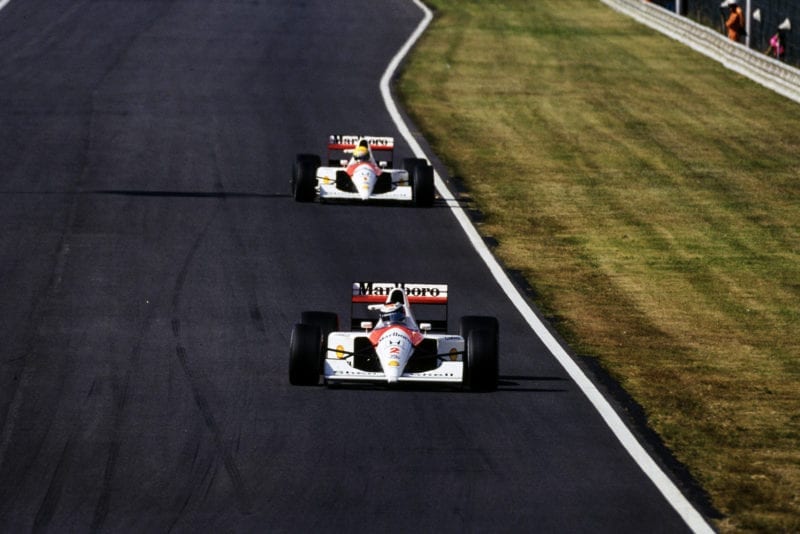
Gerhard Berger heads up a McLaren one-two finish
Motorsport Images
If, the two Iberian races apart, we can take Senna’s driving standard as a fixed factor, the most significant part of his third championship has been the ability of McLaren and Honda to react to the continuous challenge of Williams and Renault. As we recently recorded, both parties have pulled out every stop during the course of the season, yet going into the penultimate race McLaren appeared to have the psychological advantage. Where Williams spoke of promising tests, conducted at Estoril on the way back home from Barcelona and mainly aimed at 1992, McLaren and Honda had been pounding round accumulating mileage that would directly affect the MP4/6s at Suzuka. There were further aerodynamic revisions to complement the new undertray used in Spain. Shell had a further altered fuel specification. And Honda had built yet lighter and higher revving versions of its RA121E V12. By the time free practice had begun, it seemed that Williams Renault had lost its vital edge, had stumbled right at the very end. The performance advantage was back with McLaren.
Berger, as had been his wont in both Portugal and Spain, tucked up Senna yet again to take pole position, and he looked as confident as any man can after enduring defeats by his team-mate in almost all of his previous McLaren outings. By precious irony, Senna was thus unable to capitalise on the switch of pole position from the right of the grid to the left, where he had wanted it last year only to be denied by FISA and the organisers.
Mansell was very quick in qualifying, once Williams had trimmed down the FW14’s wings, and but for a moment baulking by Alex Caffi in the final corner the chicane, the curiously named 130R Bend, he might have worked on to the front row. That much was by now pretty standard; the key would be the McLarens’ speed on raceday. In recent races they have been quick in qualifying and slower than the Williams in the race. “This time,” said Senna, “we believe that qualifying speed and the improvements that led to it, will still hold good for the race.” They did. He was a half second quicker than Mansell in the Sunday morning warm-up, and though there was much talk of the manner in which he had had to switch to the spare MP4/6 to record that time, the alarm bells were ringing in Frank’s camp.

Ayrton Senna on his way to a second-placed finish and the world championship
Motorsport Images
The start: oh, was there ever a lot of soul-searching speculation about that! Senna had a dig at Mansell in his Thursday press conference, issuing all kinds of silly threats; and Mansell parried them with an ominous warning that might have reminded the Brazilian of Spa 1987. “I think Ayrton knows that I’m not as benevolent as Alain,” he said.
Well, this time the start was very clean. Hail Moses! Sweet relief! Berger went off like a man demented, while Mansell cut tight across the very fast-starting Patrese but was too slow to beat Senna into the dreaded first corner. Round one to McLaren.
Behind the scenes Ron Dennis, Senna and Berger had hatched a plot. The guy who led would be the guy who would win, all things being equal. If the McLarens were one-two, without pressure, it was said, then there would be no overtaking.
There certainly wasn’t to be any for Mansell. Stuck in the position he must have dreaded most, with Berger going away and Senna cannily doing just enough to fend off his challenges while conserving his tyres, all he could do was harry the Brazilian in the hope of forcing an error. After the formation laps he had tried running more wing than Riccardo, and stayed that way for the race. He had also opted for the thicker carbon brake discs. In the end, when it did come, the error that decided the title outcome once and for all would be Nigel’s.
There was, he said, a brake problem. The Williams’ middle pedal went very soft. It had been a problem in the morning, too. Those who watched the helicopter shots into the chicane, during the first nine laps, saw how much ground the Williams made under braking, but the mechanics were satisfied that there had been a genuine problem, which has been associated in the past with those thicker discs.
Whatever, as Mansell dived into the second part of turn one on his 10th lap, closer than ever to the McLaren, the Williams ran wide, got its left-hand wheels on the kerb, and was then launched into a long, long sideways moment across the gravel run-off. The cloud of dust it raised as it bounced and slithered to a backward halt finally choked off any title aspirations that he harboured. Portugal might have been Team Willy’s fault, but this one looked suspiciously down to the driver, a victim of the dirty air behind the McLaren and that braking glitch.
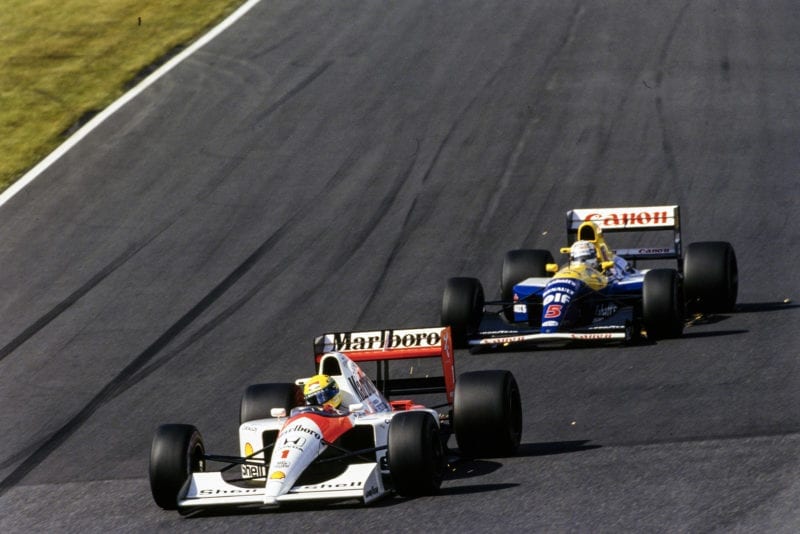
Senna leading Mansell into Turn One
Motorsport Images
“I’ve seen the same thing happen to Senna, but he got away with it,” said one observer. “Nigel had to try and ride it out, and was just plain unlucky.”
“When I saw him go off I cannot say I was sorry because I knew he was having one hell of a time in the turbulence behind me,” said Senna. Mansell clung to the brake theory, stressing how stable the FW14 had been through the corner and how the long pedal had caught him by surprise. Only he knows what really happened, but his demeanour afterwards certainly did not suggest anger at the mechanical state of his car.
With Mansell gone the Japanese GP should have fallen neatly to Berger. “After Nigel retired it was almost an instant reaction for me to think ‘Right, we’ve got to go for it and we can have some fun’ said Senna, and go for it he did. The race now simply seemed a matter of which McLaren-Honda driver won. It wasn’t quite that simple, however.
When Mansell went out Berger was nearly 10s ahead of Senna. “But then I heard from the team what had happened and that I could slow down. They said to take care about the revs. So there was no problem for me to do that. I did, and I was happy to because my tyres weren’t too good anymore. But Ayrton was pushing and I was three or four laps slowing down. Then I saw that maybe he wanted to make a nice race today, so I had to start pushing again.” Berger had been well hooked up, setting fastest lap four times in the first five laps. Senna came back at him on laps 11 and 16, and that was sufficient to pull him a lot closer. The conservation of his rubber was proving critical, but then Gerhard had been the rabbit sent out at the start either to break Mansell’s challenge if it came, or to lure him into an error should he get marooned behind Senna. There was also the fact that Gerhard had backed off, on team advice. The Austrian paid the price for aiding his team-mate on lap 17 as the two MP4/6s went by the pits nose to tail, and within a lap Senna was in the lead. If there was a no overtaking agreement, it had been violated.
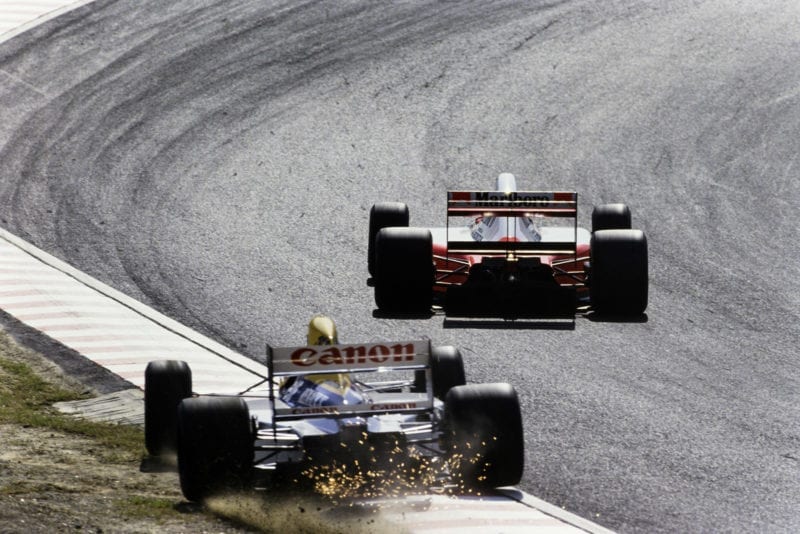
Mansell dips two wheels over the limit and into the gravel
Motorsport Images
Goodyear had warned that the tyre stops would occur around that point, and when Berger came in on lap 19 his was the longer call. Senna’s, two laps later, went like clockwork. Riccardo Patrese, quick enough to set a temporary fastest lap on lap 27, was an outrun third until the McLarens stopped, whereby he inherited the lead for two laps until his own tyre change. Senna was looking good.
Berger, however, had other ideas, and began coming back strongly with a flurry of fastest laps, a fresh one per tour from laps 21 to 25 inclusive. Perhaps this wasn’t so dull after all! His final shot was lin 41.689s on lap 37, but Senna’s ultimate response was 1 m 41.532s two laps later. Then it all began to go wrong for the Austrian, as his engine began to sound very flat on lap 45. The two, sometimes three, second gap that there had been since lap 21 began to open out quite noticeably. Going into the final tour it was 6.98s and the cause looked hopeless, but then there was Senna slowing, slowing. Were they going for a grandstand finish? Or were Dennis’ orders finally going to be obeyed?
“I was just getting Ayrton’s slipstream,” said Gerhard, “but then I got the big engine noise. An exhaust, maybe. I thought, ‘That’s it.’ I wasn’t expecting it to make even another half lap, it was that bad. I was so disappointed. I just switched down the revs and changed gears early, yet all the temperatures stayed the same. I just couldn’t believe it in the beginning. The engine just kept running. So I decided I’d have a look for second place and take home some points. Of course,” he added, remembering the deal that had been discussed, “I was hoping that Ayrton was thinking about me because I was for sure thinking a lot about him!”
Indeed, Senna was thinking of him, but only when he had exited the chicane for the last time. By then Gerhard had been allowed to erode that cushion of almost seven seconds, and as they lined up for the right-hander leading on to the pit straight Senna waved Berger through for the win.
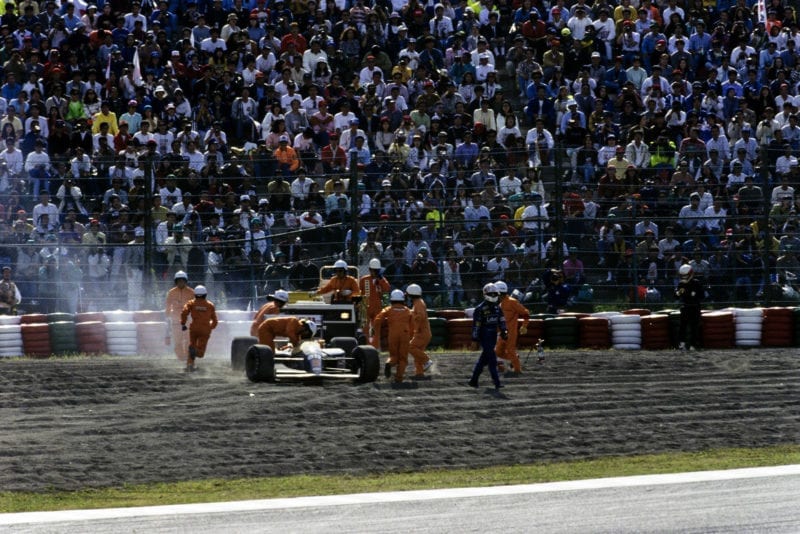
Mansell walks away, his championship hopes over
Motorsport Images
“When Mansell went out Ron immediately called me on the radio and said please remember the constructors’ championship,” said Senna. “I said ‘Shit.’ This is racing and you’ve got to go for it. I’d been waiting for this situation for many races now because I had to play the points situation for the last four or five events. It was always like I was going backwards, being conservative. I don’t like that way of driving.
“I knew Gerhard was ahead of me by 10s but he had to push very hard early on and I had been easier, because it was an agreement between us. Whoever would be in the lead, the other would help to go away.”
He wanted, he said, to put on a show for the fans. “It was a fantastic race between us, but then I realised he’d backed off. I thought, ‘Shit, at the end, if I’m still in the lead because I did not know, he was really going for it I did not know if I could hold him to the end. I would have to back off for the first time in my career for a race that I had fought for all weekend and so long’. It really hurt. In the last 10 laps I asked Ron if he wanted to change the plan or not. I did another lap, then another, and another. I kept thinking, ‘I have to ask, I have to ask!’ Then I got something on the radio, but at first I couldn’t understand the message. Finally I backed right off, revs really low, no noise from the engine, and I said to Ron, ‘You want to reverse?’ and he said, `Yes, reverse.’ Today was my turn to give Gerhard a small help, but it was only small, because he was as fast as I was today. It hurt here,” he touched his heart, “but that pain is nothing when compared to the feel I have with the third title.”
It was all good stuff, as he and Berger bantered, but the real bombshell was about to be dropped (see Delirium Tremens).
As they joked, Patrese was the first to offer his congratulations. Like Mansell, he had been as quick as the McLarens in race trim, but nowhere near a position to challenge even though at one stage he was catching Berger as Berger caught Senna. Second gear had gone awol quite early on, and without that his Williams was defeated, finishing a distant third on a day when Honda really got its act together in its own backyard.
If Williams was in disarray, Ferrari was plummetting to the depths. It was hard to believe, as Jean Alesi’s engine exploded on the first lap and Prost’s smoked ominously on the grid, that Ferrari had ever been in such contention for the 1990 title.
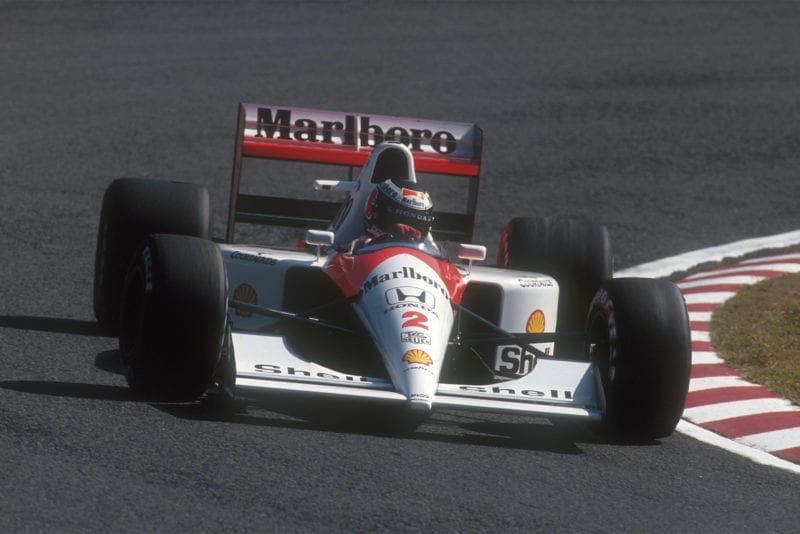
Berger in his McLaren on the way to victory
Motorsport Images
The 643 felt reasonable at times and at certain parts of the circuit, said Prost, but it was no match for either of its main rivals. Indeed, there had even been much speculation prior to the race that Prost would not be there, and there was as much afterwards that he would skip Adelaide. Ivan Capelli, replaced at Leyton House by Karl Wendlinger (who would do a competent job, but be eliminated along with the Dallaras of Lehto and Pirro at the end of the second lap when de Cesaris got the chicane all wrong and spun in the right-hander leading on to the pit straight, causing chaos behind), was the man who would have taken over, but in the end his presence was not required.
As the two Williams initially chased the McLarens, Pierluigi Martini and Michael Schumacher fought long and hard over a place that was finally destined to go to M Brundle in a revitalised Brabham Yamaha. For Martini and Minardi, it was another chance to show that, given better financial fortune this year, they might have done something really good with the Ferrari engines that will shortly go to rival Dallara and Piero was backed strongly by team-rival Gianni Morbidelli until the latter’s expired from a fading ninth place with wheel bearing failure. Martini went 25 laps further, fending off the determined Schumacher, but neither made the finish.
The German’s performance was all more impressive given a very heavy 150 mph shunt in qualifying which had wrecked Piquet’s Benetton, which he was borrowing. Despite a stiff back and neck he raced aggressively as ever, and appeared not the slightest put out by the experience. Only engine failure, the corollary of a race-Iong water leak, could stop him on lap 35. Laps later Martini was also gone, the victim of an obscure clutch failure which damaged electrics. If this duo had provided the real excitement in a dull race, though, both Brundle and new boy Alessandro Zanardi also did their bit. With team-mate Mark Blundell failing to pre-qualify following an oil leak, Brundle flew Yamaha’s flag brilliantly making full use of the latest and glorious-sounding version of the V12 and latest rocket fuel, and was catching both Schumacher and Martini even though the Brabham was puking oil for the first half the race. Irritated by suggestions that German will annihilate him at Benetton next year, he drove like a man with something to prove. Zanardi did too, actually passing Schumacher on lap seven as they went down into the first turn. That in itself is noteworthy, and although second gear refused to disengage almost immediately thereafter, the young Italian made a solid impression in his second F1 outing.
Stefano Modena, Piquet and Gugelmin didn’t, but the Italian survived for a sixth place that disappointed after the team felt it had found almost two seconds during testing of suspension modifications at Silverstone prior to the race. Piquet’s race was blighted by the need to change a front suspension joint on the grid, a job which, despite the speed of his mechanics, meant he had to start from the back. It was interesting, though, that he killed his tyres in traffic and was never able to escape from Johnny Herbert’s beautifully driven Lotus as long as the Briton was running. “I could keep up with him in the corners, but he had more power than me so I just couldn’t stay with him on the straights.” said Johnny after another underrated performance. After their tyre stops he was again chasing the Brazilian strongly, when the Lotus joined Mika Hakkinen’s sister car in retirement. The Finn had simply spun, but Herbert’s engine died with earth lead failure.
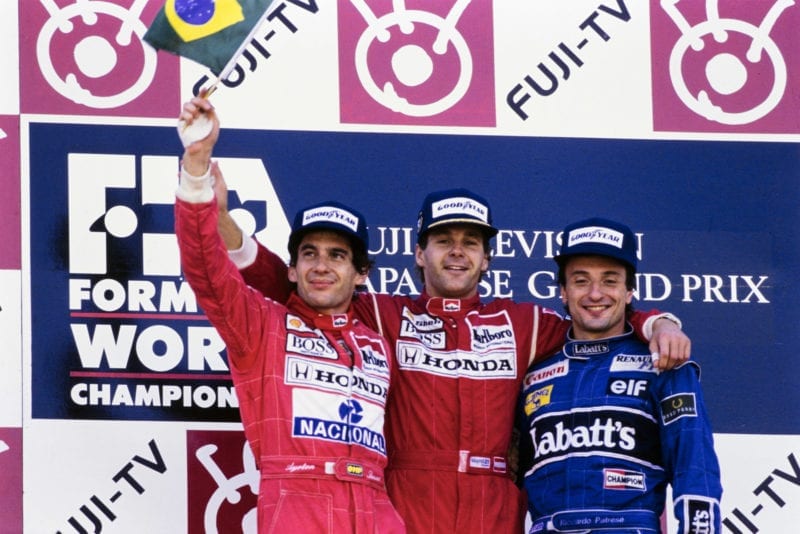
Second was good enough for Senna to be crowned champion
Motorsport Images
Neither of the home heroes made it to the flag, Nakajima spinning off and Suzuki suffering engine management system failure, while Erik Comas’ brave charge up to seventh place behind Brundle and Modena was thwarted by alternator problems in the tank-like Ligier JS35B. Team-mate Thierry Boutsen, having narrowly avoided involvement in the four-car mêlée at the end of lap two, soldiered his home ninth ahead of Alex Caffi, who was delighted just to qualify his Footwork for his first race since last year’s Japanese GP. Gabriele Tarquini, his left knee extremely sore after an 8g impact during a Friday morning shunt, did well to take the final finishing position for Fondmetal.
Not since 1988 has the Japanese GP been devoid of argument, and just when it seemed F1 had escaped it and everyone settled down to unwind now that the tension of the title chase had gone, so Senna exploded into his blistering attack on the deposed and absent Jean-Marie Balestre. The Japanese threw their hands up in horror (Honda’s people in particular, one suspects), but across the water the Australians took their heads from their hands and sensed a glimmer of hope. The championship might be over, but for them, at least, the controversy might have a silver lining. Sometimes there is nothing quite like an ongoing grudge match to boost a race-day gate. — DJT
***
Results (top five), Japanese GP, Suzuka, October19
53 laps of 3.66 (5.88 km) circuit (193.98 miles; 311.64 km)
1. Gerhard Berger, AUT, (McLaren MP4/6 – Honda V12) 1h 32m 10.695s
2. Ayrton Senna, BRA, (McLaren MP4/6 – Honda V12) 1h 32m 11.039s
3. Riccardo Patrese, I, (Williams FW14 – Renault V10) 1h 33m 07.426s
4. Alain Prost, F, (Ferrari 643 – Ferrari V12) 1h 33m 31.456s
5. Martin Brundle, GB, (Brabham BT60Y – Yamaha V12) 1 lap behind
Conditions: Overcast and cool
Winner’s Average Speed: 125.702 mph (202.25 kmh)
Fastest Lap: Ayrton Senna (McLaren MP4/6 V12) 1m 41.532s on lap 41; 129.195 mph (207.87 kmh)
